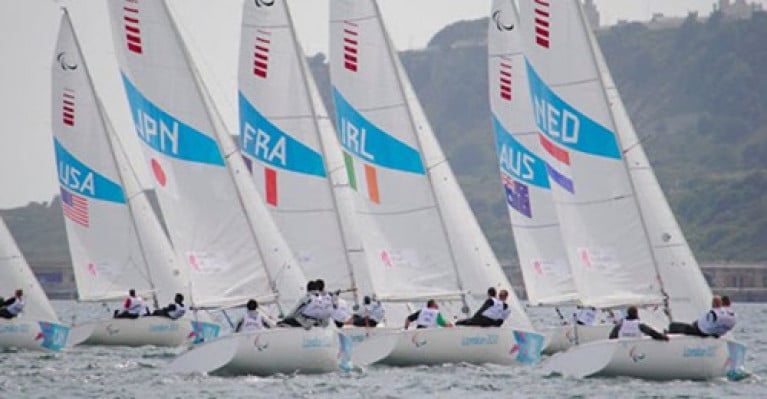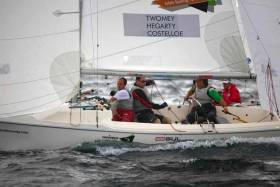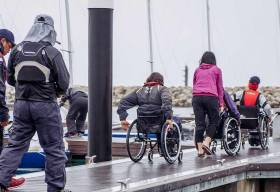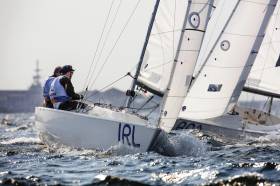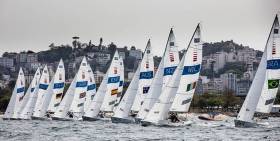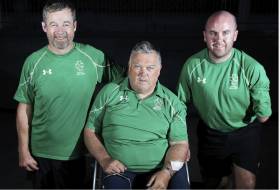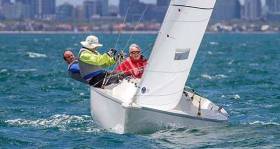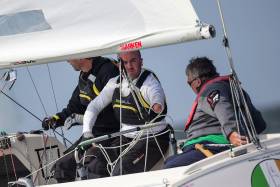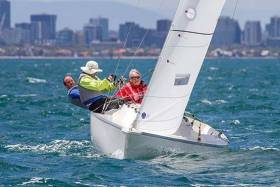Displaying items by tag: Paralympic
A Fine Gael Senator has thrown his support behind the campaign by World Sailing to reinstate sailing as a Paralympic sport in the 2028 Games in Los Angeles.
Senator Barry Ward said, “Sailing featured in every Paralympic Games between Sydney 2000 and Rio 2016, but unfortunately it did not make the cut for the 2020 Games in Tokyo. It is a sport in which Ireland does well. We all remember, for example, the silver medal win by Annalise Murphy, who sails in my own club in Dún Laoghaire, at the 2016 Olympic Games.
“Sailing is an inclusive team sport, and globally, the sailing community does not distinguish between athletes who are able-bodied and athletes who are not. We all compete together with the same rules.
“There are plenty of athletes with a range of physical, sensory or intellectual disabilities who would like to compete, and represent their country in Paralympic sailing.
“World Sailing, which is the global governing body for the sport, is currently building support to reinstate sailing as a Paralympic sport in time for the 2028 Games in Los Angeles. While the International Olympic Committee is yet to confirm the bidding process for the Games, I fully support World Sailing in their efforts and call on my colleagues across Government and the Oireachtas to do the same,” concluded Senator Ward.
This week World Sailing officially kick-started their campaign for sailing to be reinstated at the Paralympic Games in Los Angeles (USA) in 2028.
The governing body has outlined a set of strategic priorities to support the growth of the sport by 2023:
- Increase worldwide participation to 45 nations on 6 continents.
- Increase youth participation (below the age of 30) to 20% of total athletes.
- Grow the number of female participants to 30% and, ultimately, to achieve gender parity.
Focusing on diversity, inclusion, affordability, development, and increasing the number of open and Para sailing events are all part of World Sailing's framework to build on the success of Para sailing.
"We know that other major sports looking for reinstatement are already drawing up their bid plans," commented David Graham, CEO of World Sailing. "We know that IPC President, Andrew Parsons, has already publicly declared that the IPC will be looking at potential 'new sports' following the successful introduction of new, youth-focused sports at Tokyo 2020. We are on track to achieve our strategic priorities by 2023 and we are taking nothing for granted."
The International Paralympic Committee (IPC) has yet to confirm the bid process for LA28, however World Sailing is proactively launching its campaign to galvanize support and build on the growth of Para sailing: "It is a critical task of World Sailing to reinstate Para sailing in the Paralympics," stated Quanhai Li, President of World Sailing. "We must pro-actively coordinate with the International Paralympic Committee to further understand the entry standards and requirements, and I am in direct contact with the IPC President on this matter as we continue our work towards reinstatement at the Los Angeles Games in 2028."
The 2028 Summer Paralympic Games, known as LA28, will be the first held in the United States since 1996 when Para sailing made its debut at the Atlanta 1996 Paralympic Games as a demonstration sport. Para sailing was a successful Paralympic sport for five consecutive Games from Sydney 2000 to Rio 2016.
Strong Irish Interest in Proposal that Sailing Has Done Enough to Return to Paralympic Games at Los Angeles 2028
World Sailing President Kim Andersen has claimed that the sport is in a strong position to lobby for a return to the programme at the Paralympic Games in time for Los Angeles 2028. This rings many bells in Ireland, as John Twomey of Kinsale has an unrivalled record of successful national representation in the Sailing discipline, which had featured at the Paralympics in every Games between Sydney 2000 and Rio 2016. But in 2015 it was announced it was being dropped for Tokyo 2020., and last year, it failed in a bid to return for Paris 2024.
Sailing was axed - along with football seven-a-side - for the Games in the Japanese capital because the International Paralympic Committee (IPC) claimed it could not fulfil their minimum criteria for worldwide reach.
"It was unfortunate that Parasailing was removed from the Paralympics before my tenure, but during my time this has been among my priorities to ensure that we put in place a strong Parasailing structure with the goal of once again being part of the Paralympic Games," Andersen said in a message released as part of his current election campaign for World Sailing’s Presidency.
"With our new 2020-2023 strategy for Parasailing, which shows how World Sailing will continue to grow, promote and develop all Para disciplines worldwide, I believe that we have a strong foundation to make our case to the IPC.
"Parasailing has a unique capacity to include people from all ages and abilities. Positive steps have been made over the past few years with the Parasailing Development Programmes to increase participation by 30 per cent. Furthermore, with our strong links to the IPC, we have already began discussions to getting back into the Paralympic programme for 2028".
Abhorrent Treatment of Disabled Sailors
Hello and welcome to my weekly Podcast …. Tom MacSweeney reporting on current sailing and maritime topics and this week, reflecting on how I have been fortunate during my years of sailing and reporting the sport to meet many disabled sailors, physically challenged in a sport which requires physicality and who were most impressive in the way they overcame the challenges they faced and established themselves on the water….. So I find the exclusion of sailing once again from the Paralympics to be abhorrent and discriminatory…. Strong words, but justified I feel following the exclusion of sailing from the Paralympic Games to be held in Paris in 2024, which follows the exclusion of the sport from the 2020 Games in Tokyo.
Sailing is one of the most inclusive of sports, which the Chief Executive of World Sailing, Andy Hunt, summed up accurately when he said that, “Regardless of their classification, sailing’s athletes compete on a level basis with able-bodied sailors…..”
The Paralympics Committee has taken the view that sailing is “not in compliance with one or more of the core criteria for Games inclusion” That is disputed on the numbers criteria used, which stipulates that sports accepted for the Games must be widely and regularly practised in a minimum of thirty-two countries and three IPC regions.
"...sailing’s athletes compete on a level basis with able-bodied sailors…”
World Sailing claims to have exceeded the worldwide reach criteria. Following the removal from the 2020 Paralympics, it launched a strategic plan that resulted in 80 sailors from 37 nations and five continents racing at last year’s Para World Sailing Championships. The annual Championships are being held in Wisconsin this week, with a record 101 sailors from 42 nations registered to race.
World Sailing is seeking a meeting with the Paralympics Games leadership about the decision … Disabled sailors have told me that the world sailing organisation could have given more support to disabled sailing in the past, but did so after the exclusion of the sport from the 2020 Games….
I was approached by the father of a disabled youngster who wanted to get him involved in sailing, but said he had found it confusing to do so. Not being a member of any club, when he sought information on the Internet and found a reference to Sailability Ireland as being “supported” by Irish Sailing… He was unsure how to get his son involved. Perhaps the sport needs to make the pathway to involvement clearer…
There has always been positive support in the clubs towards involving disabled sailors and it is a strong memory of mine how in one of my first interviews with a disabled sailor I was told that being on the water provided a sense of freedom and equality of competitive effort. Ireland has competed strongly at the Paralympics…. John Twomey of Kinsale Yacht Club, which has been strongly involved in promoting sailability, being particularly outstanding for his many years of involvement and several other sailors too.
Thinking back to that father who approached me – and also conscious that, perhaps, “disabled sailors” is not completely the best or most accurate, correct description to use - and that “challenged” could be better …. Perhaps more could be done to make the pathway to sailing clearer for those who are physically challenged….
Sailing Not Included on Paris 2024 Paralympic Games Sports Programme
World Sailing says it is shocked and disappointed to learn that sailing has not been included by the International Paralympic Committee (IPC) for the Paris 2024 Paralympic Games.
The decision came (13 September 2018) following an IPC Board meeting earlier this week in Madrid, Spain.
Sailing’s application was submitted ahead of the 9 July 2018 deadline and World Sailing have been informed by the IPC that Sailing is not in compliance with one or more of the core criteria for Games inclusion as stipulated in the IPC Handbook.
"Sailing was removed from the Tokyo 2020 Paralympic Sports Programme for failing to meet worldwide reach criteria"
World Sailing will meet with the IPC´s leadership as soon as possible to further understand the details of the decision taken and the analysis by the IPC management team.
“We worked tirelessly to ensure sailing met the IPC criteria and our application was of a high standard and everyone at World Sailing is deeply saddened by the news from the IPC,” said Andy Hunt, World Sailing CEO.
“Sailing is one of the most inclusive sports and caters for all athletes. Regardless of their classification, sailing’s athletes compete on a level playing field and we have reiterated this message to the IPC.
“So much has been achieved over the past few years in developing Para World Sailing and we will continue to provide a programme of events for the sailors that compete regularly at a national and international level.”
Sailing was removed from the Tokyo 2020 Paralympic Sports Programme in January 2015 for failing to meet worldwide reach criteria.
The IPC Handbook states, “For Paralympic Games Only individual sports and disciplines widely and regularly practiced in a minimum of thirty-two (32) countries and three (3) IPC regions may be considered for inclusion in the Paralympic Games.”
Following this news, World Sailing released a strategic plan for 2017-2020, outlining strategic goals and strategies that were adopted by World Sailing to gain re-inclusion into the Paralympic Games sports programme.
Para World Sailing has had a period of accelerated growth through initiatives such as the Paralympic Development Programme (PDP) that culminated in more than 80 sailors from 37 nations and five continents racing across three events at the 2017 Para World Sailing Championships.
Paralympic Development Programme clinics have ensured continued development of Para World Sailing on all continents and continue to help increase participants' knowledge and understanding of the sport.
At the 2018 Para World Sailing Championships, which will be held in Sheboygan, Wisconsin, USA from 16-22 September, a record 101 sailors from 42 nations have registered to race across four events. A PDP clinic is currently being held ahead of the Championships with sailors from China, Indonesia, Latvia, Samoa, Thailand and Chinese Taipei all receiving World Sailing support.
At the 2017 and 2018 World Championships, World Sailing demonstrated that it met and exceeded the worldwide reach criteria and worked in close partnership with Member National Authorities, Class Associations, Event Organisers and sailors to ensure the best possible application to the IPC.
Further development of Para World Sailing has included the introduction of a representative in the Athletes’ Commission. Jens Kroker was appointed earlier in the year. And at the next Sailing World Championships, set to be held in The Hague, The Netherlands in 2022, the Para World Sailing Championships will be integrated for the first time.
Despite this enormous setback for the discipline, World Sailing says it will continue to support the sailors as well as grow and promote Para World Sailing globally.
Tributes to Kinsale's John Twomey as Paralympic Sailing Ambassador Retires in Rio
John Twomey bowed out of his Paralympic sailing career in Rio at the weekend after a tricky series left the Irish Sonar crew in 13th place overall. Kinsale's Twomey, Ian Costelloe and Austin O'Carroll had hoped to finish on a high especially after seeing training partners finish in the medals.
Twomey retires from Paralympic sailing, marking the end of a career that includes 11 Paralympic Games, a bronze and a gold medal in the discus and finishing in Rio proudly carrying the Irish flag in the opening ceremony.
'Our two training partners took silver and bronze and we are just as fast as they are, we just didn't have the knack of dealing with the winds here,' Twomey told RTE news.
The Rio regatta was a significant day for Ireland in Paralympic sport as it marked the retirement of one of Paralympics great ambassadors and Ireland's longest serving competitor.
'Sonar skipper John John leaves behind an impressive legacy in Paralympic sport that will surely serve to inspire the next generation of Paralympic sailors. Thanks for all the years as a great competitor John and we wish you all the best in your next endeavours, ' an Irish Sailing Association (ISA) post on social media said.
In a finale fitting on the setting, the Rio 2016 Paralympic Sailing Competition came to a spectacular close with the medals decided in front of a sell-out crowd lining the shores of Flamengo Beach.
Racing on the Pao de Acucar (Sugarloaf Mountain) race course, onlookers were treated to a thrilling climax in which some medals were settled by just seconds.
After 11 races under the backdrop of Sugarloaf Mountain and Christ the Redeemer, the stakes were high for a chosen few sailors who had the opportunity to grab a Paralympic medal. But while some would feel the elation, some would inevitable miss out.
With the gold wrapped up in the Sonar by the Australian team of Colin Harrison, Russell Boaden and Jonathan Harris with a race to spare, it was down to the battle for silver and bronze.
Mathematically there were still quite a few teams left in the fight, but USA and Canada, sitting in second and third respectively, had the advantage before the final race got underway. That advantage paid dividends in the end as Alphonsus Doerr, Hugh Freund and Bradley Kendell (USA) confirmed silver with Paul Tingley, Logan Campbell and Scott Lutes (CAN) taking bronze, but only just.
USA set their stall out early and headed for the top end of the fleet, they knew where they needed to be. At the half way point they hit the front, and they stayed there to claim a race win and the silver medal.
Kendall will take to the podium with his teammates, but he had to endure a restless night as he knew the pressure was on, "Not much sleep last night, not much sleep. Woke up in the middle of the night and certainly started thinking about the race and how we were going to get out there and manage it and what we had to do. We wanted to win that race and go out in style and that's what we do. But not much sleep.
Freund bounced in with enthusiasm, "I slept great last night and woke up early and did some yoga.” "Good for you,” said Kendall. The sleep patterns may be different but the collective result was the same.
Claiming the 2016 Para World Sailing Championships earlier in the year had given the Americans the experience to call upon when faced with a similar final race situation, "We went into today knowing we'd had one rough day and four pretty good ones and we were in the same position we were in before the world championship with everything to play for. We knew if we sailed the boat the way the three of us know how to, everything would work out. It was really good execution from every person on the team.”
Race execution paid, but there was also a little help from another source as Kendall called in an old 'family favour', "I'm half a New Zealander, my dad was from there. The Kiwis sort of owed us a favour from the other day. They really fought with us at the end. They weren't giving us too much. We knew we had to go straight to the finish line as fast as we could and we were still working on sail trim on the reach. That's what it was all about.”
New Zealand's Richard Dodson, Andrew May and Chris Sharp rounded the first mark back in eighth position, but from there they charged to the front to worry the Canadians. The Kiwis pushed USA right to the finish but missed out on the bullet by just one second.
Further back the Canadians weren't making life easy for themselves. From the start they fell to the back and had to pick off a few boats and make their way through the field in the hunt for a medal.
USA had beaten New Zealand to first by one second and Canada eventually pipped France by one second to get seventh. That collective two seconds had shaped the medal podium as Canada and New Zealand where now tied on overall points. The Canadians won on a countback thanks to two race wins to the New Zealanders one.
For Campbell, it was all a bit too close for comfort, "We were unsure on the results and it probably took three or four minutes to find out where we finished, but we didn't know until our coach told us. We knew it was tight and when racing was done it was a pressure release.”
Teammate Lutes summed up for the team what the being on the podium means to them, with a traditional culinary reference, "It's a treat, it's a treat,” he chuckled. "We love racing and that's why we do it. No matter what, happy to be here but on a cake, icing is nice and this is the icing on the cake.”
Twomey's Sonar Crew in 11th in Rio, One More Day of Fleet Racing To Go
Another far from easy day in Rio for John Twomey's Irish Sonar crew in the Paralympic sees the KInsale Yacht Club trio drop to 11th overall. Twomey, Ian Costelloe and Austin O'Carroll have one more day of fleet racing to decide places for Sunday's medal race.
The Australian Sonar team remain on top of the fleet to help their country lead across the board.
A bullet and a third gave Colin Harrison, Russell Boaden and Jonathan Harris another solid day of scoring, leaving them on 16 points to lead the fleet at the end of eight races. The Aussie team have been on it all week posting consistent top finishes, but to USA's Alphonsus Doerr, that isn't really a surprise, "Here's the thing, they have been the most consistent all year. Way back in Melbourne [at the 2015 Para World Sailing Championships] at the end of last year they were leading the regatta and just missed out at the end. Since then they have been on the podium in just about every regatta.
"It's consistency that wins and they are playing great ball right now. We would love for them to go haywire and we jump them, but we can only focus on our job.”
Doerr, along with teammates Hugh Freund and Bradley Kendell, are the closest challengers to the Australians and had a mixed day with some indecision counting against them in race one, "There were lots of debate for us other whether we played the current or the wind shifts and it confused us a little bit. We were just overthinking it.”
All singing from the same hymn sheet in race two, the Americans got back on track, "The second race you could use the current more. We did that and got a second after a fight with our mates and training partners, the Canadians. Overall we are pleased with the day though and we will take second on the leaderboard.”
With Australia on 16 points, USA on 27 points in second and Paul Tingley, Logan Campbell and Scott Lutes (CAN) on 35 points leading a chasing pack in third, it's hard to know which way Doerr and his teammates need to look, "I'm trying to figure if it's a 50/50 or 60/40 thing. We still look forward, and we always will look forward. But it's a tough question. We have to look forward but also look back at what's chasing you.”
Anyone in the top nine is still in with a shout of a medal in the Sonar. With a gold medal from Athens 2004, Israel's Dror Cohen is hoping that him and his teammates Arnon Efrati and Shimon Ben Yakov can sneak in above a tough field for another Paralympic medal, but he knows it won't be easy, "At last we had a consistent day today. I need to see the scores but I know it is close. We will fight to the end and try to get it but it's going to take persistence and whoever wants it more will get it.”
The obvious next question. How much does Cohen want it? "I want it the most.”
Cohen sits in seventh place on 38 points, in the mix of six teams separated by five points currently chasing the bronze medal.
The racing continues at the Rio 2016 Paralympic Sailing Competition on Friday 16 September with all fleets scheduled for two races. The Sonars are on the Escola Naval course at 13:00 local time with the SKUD18 and the 2.4 Norlin OD fleet on the Pao de Acucar (Sugarloaf Mountain) area at 13:00 and 13:10 respectively.
Twomey, Costelloe & O'Carroll Move Into Top Ten At Paralympic Regatta
On the third day of the Rio Paralympic sailing regatta, Ireland's John Twomey from Kinsale Yacht Club with crew Ian Costelloe and Austin O'Carroll are back into the top ten overall after counting a fifth in race six of the three person Sonar keelboat class. Ireland scored also scored a 9th and 13th yesterday moving them up to tenth overall. Full results here.
Race day three. Three people in a boat. Three races. Three wins. If three isn't the lucky number for Great Britain's Robertson, Stodel and Thomas then it certainly should be after today.
Languishing in the bottom half of the fleet with a 11,9,14 on the scorecard it looked like the chase for a medal was over before it had begun for the British team. Whatever went on in the nightly debrief after day two, it definitely worked.
Not giving too much away, Thomas said, "Some of the stuff we talked about last night in the debrief we came out on the water today and implemented.”
He continued, "The debrief from last night was mainly to believe. Which then allowed us to follow our plan. So believe and then execute with a positive mindset. We love the medium to strong breeze and we have been working on a few techniques with our new coach which are working.”
If the team is to continue up the leaderboard and get a first Paralympic medal in their fourth attempt, they will need a lot more of that belief that worked so well, but they also need boats around them to falter. For Thomas though, their destiny is still in their own hand's, "All we have to do is worry about our own performance and not worry about the others. Having three firsts makes you feel positive and I'm not sure how that has helped us with the overall scores. The boat is going well now, and we can't influence others.
"For us it is about sticking to our processes and coming out strong and delivering on what we can do. If we can then be in the medal zone we will be happy.”
The Britons now sit in fifth place on 23 points.
Still leading the way are the Australian team of Colin Harrison, Russell Boaden and Jonathan Harris who posted two second places and a discarded seventh for the day to leave the team on 12 points. They are followed in second by 2016 world champions Alphonsus Doerr, Hugh Freund and Bradley Kendell (USA) who rocketed up from seventh place with a 2,3,3 to finish on 18 points.
New Zealand's Richard Dodson, Andrew May and Chris Sharp are third on 21 points with London 2012 bronze medallists, Norway's Aleksander Wang-Hansen, Marie Solberg and Per Eugen Kristiansen just one point back on 22.
Ireland's Paralympic Sailing Crew Prepare for Rio Challenge
Ireland's Sonar Paralympic team John Twomey, Ian Costello and Austin O'Carroll are preparing for the Paralympic Games that take place between 7–18 September in Rio de Janeiro. The sailing is scheduled to be raced between 12–17 September in Guanabara Bay.
Sailing at the Paralympic Games is one of the only sports in which athletes of many different disabilities compete against each other on equal terms.
The upcoming Paralympic Games has so much to offer for the competitors and the viewing public. The adaptations on the boats, the 2.4 Norlin OD, SKUD18 and Sonar, allows a wide range of disabilities to compete in a beautiful backdrop of iconic sites like Christ the Redeemer and Sugarloaf Mountain. Just look at the images that came out of the Olympic Games. The Para athletes will have those same images in just a few weeks time.
More information here
The 2016 Para World Sailing Championships came to a breathtaking finale in Medemblik, the Netherlands as the final race of the championships decided the medals in the Sonar fleet.
Arguably the most exciting race of the day was in the Sonar fleet as the gold medal changed hands continuously throughout. Ireland's John Twomey, Austin O'Carroll and Ian Costelloe were ninth overall in the 16–boat fleet.
Norway's Aleksander Wang-Hansen, Marie Solberg and Per Kristiansen took a bullet in the first race of the day to bunch the top four together, only separated by six points going in to the final race. The battle was on.
The final race started with USA on top, but they fell behind early and were down on the predictive rankings. Australia and Great Britain moved ahead and they changed top position on the predictive. Throw in Norway who moved up the fleet. Then USA came back. The top four on the leader board were the top four on the course fighting it out.
Great Britain's John Robertson, Hannah Stodel and Steve Thomas took the bullet, but only just from Australia's Colin Harrison, Jonathan Harris and Russell Boaden. The Britons had to wait and see if Norway could do them a favour and beat the American's to the line. They couldn't. USA's Alphonsus Doerr, Bradley Kendell and Hugh Freund had done it, they were world champions.
Describing the race, Kendall said, "The last race of the day, last race of the regatta, we knew who we had to cover and we were happy with our start, we knew where they were. The first shift we actually didn't sail to the right side that we wanted to and we had to fight our way back, but we did that.”
With four team's vying for the medals in such a close contest, Kendall was happy to get the job done, "This world championship was a very tight regatta. The world's best were here and we are so happy with what we have done and where we are at right now.”
Where they are right now is on the top of the podium and 2016 Para World Sailing Champions with 26 points.
With the final bullet of the championships, John Robertson, Hannah Stodel and Steve Thomas took the silver medal on 27 points with Colin Harrison, Jonathan Harris and Russell Boaden taking the bronze on 28.
Paralympic Sailors In Dutch Sailing Test
One of Ireland’s most accomplished Paralympians goes into action today in his final major event before the Rio Paralympics later this Summer. John Twomey with crew-members Ian Costello and Austin O’Carroll qualified in the Sonar class last December and begin racing in their world championship this afternoon.
The championship is being held as part of the Delta Lloyd regatta for Olympic classes at the Dutch sailing venue at Medemblik.
This year will be Twomey’s 11th Paralympic appearance and possibly his last as Disabled Sailing will not feature in the 2020 Tokyo games.
“Our Sonar team have had more time together as a crew than any previous season which I expect will stand to them in competition,” commented James O’Callaghan, ISA Performance Director. “They will also compete at the Weymouth Sailing World Cup regatta in June but the World Championship is their last major event before the paralympics.”
Since losing the use of his legs in a childhood accident, Twomey has competed in several sailing disciplines in addition to paralympic sport and has several championship titles to his credit.
Costello hails from Killorglin and is a veteran from the London 2012 games and is a member of Kinsale Yacht Club with Twomey. Dublin-born O’Carroll is on his first Paralympic outing and sails regularly from Tralee Bay Sailing Club.
Following this event, the Providence Team IRL trio will spend the next four months making final training preparations for their four-year highlight regatta that starts in September.




























